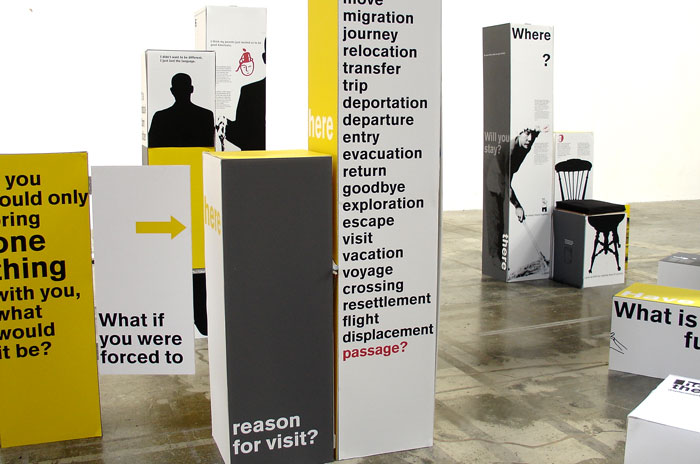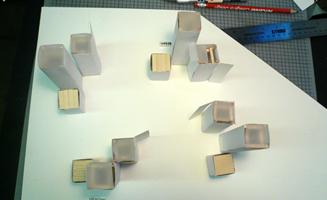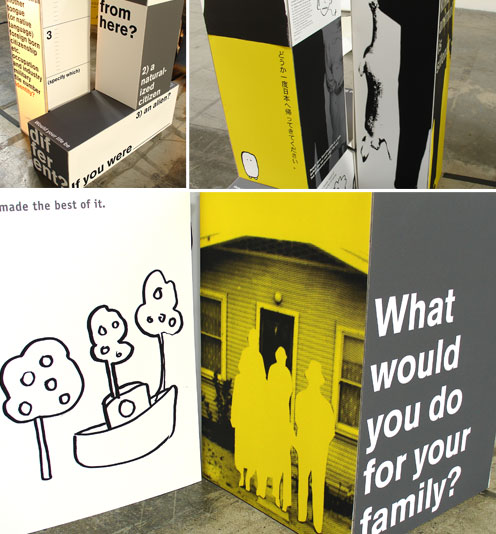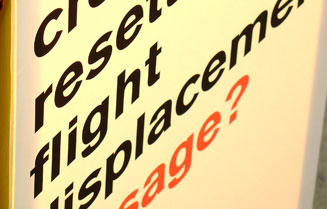INTRODUCTION: HERE|THERE
A case study: Displacement, migrations and two families
Here|there is a proposal for an exhibition presenting a collection of stories discovered through sound, light, and physical movement. The strategies demonstrate how narrative content (e.g. oral history projects) designed for public spaces (e.g. museums or galleries) in a crafted and synthesized manner can encourage more dynamic, reflective interactions—experiences that ask rather than tell.
The exhibition is intended as a prototype to explore and assess methods and build a future practice.

Offering personal entry points into larger, often challenging, subject matter, it acknowledges the relevance of a collective history to understand more universal concepts. Using storytelling as a primary device, the multi-linear narrative space offers a range of interactions that bridge the gap between individual and public experiences, between the past and the present. It seeks to create informative experiences that are not didactic, but evocative and multi-sensory.
The content deals with the two sides of my Japanese immigrant family whose lives intersect in the U.S. before and during World War II. It introduces the larger concept of “displacement” which is also a metaphor for the design of the exhibition. It reflects upon our ephemeral relationship with the past, material and immaterial objects, and of passing down stories from one generation to the next. It seeks to make viewers aware of the value of stories and inspire their own retellings.
The exhibition is designed to be site-specific for the Media Design Program studio in an area measuring 18 feet x 15 feet (however a larger space is more desirable for dealing with the density of material and sound.) The exhibition is to be viewed in the round, dimensionally with multiple entry points that offer different perspectives of the material. The design approaches are integral to the interaction and exhibition strategies. It is a modular system that offers simultaneous interactions between texts, image, sound, environmental graphics and physical movement. An ideal venue for the exhibition would be within a museum setting where the personal content can enhance and offer entry points into other exhibits.
The four story-gathering structures, each with their own communication of a theme and interaction, are placed facing each other in four corners defining an exterior and interior space. Each gathering contains a 6 ft tall main structure filled with light and audio. As the participants move through the interior space, these structures come to life. Audio (narrated story tracks) and light invite the participant to engage in the act of listening, attracting attention. Secondary boxes of varying sizes help convey the theme and encourage interaction through image and text. Sensors trigger audio and light, which are connected to activities related to each thematic gathering.

PASSAGES: moving through a gateway
IDENTITY: looking inside
HOME: having a seat
DREAMS: a close listen
The story gatherings are also used to communicate the play between personal story and larger concept of displacement using scale and location. The exterior perimeter of the space represents the general viewpoint, represented by language and oversized text. It is the point of entry to the interior, the collective space. As the participant moves into the interior space, more personal information becomes accessible—quotes, imagery, and passages from the stories are presented. Smaller text pulls in the attention of the participant to physically engage more closely with the material. The most intimate area created is in the form of storybooks, that contain the full texts of the stories, intended as a focused individual activity.



